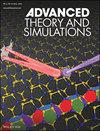First Principles Study of TiS2/Graphene Heterojunction as Cathode Material for Sodium–Sulfur Batteries
IF 2.9
4区 工程技术
Q1 MULTIDISCIPLINARY SCIENCES
引用次数: 0
Abstract
Rechargeable batteries are an indispensable part of the development of environmental sustainability, high capacity and excellent conductivity are essential for optimal energy storage. Sodium–sulfur (Na─S) batteries are recognized as promising options for stationary energy storage solutions, which can be attributed to their high theoretical energy density and cost advantages. Additionally, 2D XS2@graphene heterojunction is considered an excellent host material for batteries. Using the first-principles calculations, a novel 2D TiS2/graphene heterojunction have been theoretically investigated as an anchoring material for sodium–sulfur batteries to mitigate the shuttle effect. First, the composite structure is created by depositing a TiS2 layer onto a single layer of graphene retains its inherent metallic character. Furthermore, the calculated results show that the TiS2/graphene heterojunction exhibits adsorption energy of 1.3 eV for long-chain sodium polysulfides while maintaining its metallic properties, effectively anchoring polysulfides and inhibiting the shuttle effect. Moreover, a low diffusion barrier (0.31 eV) for Na ion diffusion shows that this heterojunction can enhance electrochemical processes. TiS2/graphene heterojunction may be the candidate for ideal anchoring materials in sodium–sulfur batteries.

求助全文
约1分钟内获得全文
求助全文
来源期刊

Advanced Theory and Simulations
Multidisciplinary-Multidisciplinary
CiteScore
5.50
自引率
3.00%
发文量
221
期刊介绍:
Advanced Theory and Simulations is an interdisciplinary, international, English-language journal that publishes high-quality scientific results focusing on the development and application of theoretical methods, modeling and simulation approaches in all natural science and medicine areas, including:
materials, chemistry, condensed matter physics
engineering, energy
life science, biology, medicine
atmospheric/environmental science, climate science
planetary science, astronomy, cosmology
method development, numerical methods, statistics
 求助内容:
求助内容: 应助结果提醒方式:
应助结果提醒方式:


